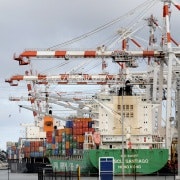One year on, our 'infrastructure Prime Minister' is still poised with a shovel
When Australian Prime Minister Tony Abbott came into office last year his aim was to be remembered as the “infrastructure Prime Minister”.
In the Coalition’s September 2013 policy to “Deliver the Infrastructure for the 21st Century”, the government promised vital infrastructure projects would be underway across the country within 12 months.
The same document promised all Commonwealth infrastructure spending exceeding $100 million would be subject to analysis by Infrastructure Australia "to test cost-effectiveness and financial viability" – analysis that would be made public.
A recent report published by the Australian Logistics Council indicated a 1 per cent increase in logistics efficiency, which could be achieved by increased spending on road and rail infrastructure, would boost GDP by $2 billion.
One year on it is time to review the government’s performance.
Infrastructure spending is a vote winner
Having a focus on infrastructure is popular with politicians: it provides tangible evidence of action and they might even have a project named after them. Why have a boring name like WestConnex or M5 when you could have the “Abbott Expressway”?
It also provides for good photo opportunities even when not a cent of public money has been spent on the project. According to Trade Minister Andrew Robb after a recent visit to New York, international funds management groups with trillions of dollars under management are “enormously excited” about investing in Australian infrastructure.
Assistant Infrastructure Minister Jamie Briggs recently said the government was investing “a record $50 billion in world class infrastructure that will leverage over $125bn of public and private investment in infrastructure over the next decade”. However, he neglected to mention that $36bn of the $50bn was already committed by the previous government.
Asset recycling remains thwarted
The federal government has set up a $5bn asset recycling fund from which it plans to give a 15 per cent bonus for each project to state and territory governments who recycle capital gained from the privatisation of state-owned entities, such as ports and utility assets.
This additional capital is mainly available for road projects with spending on rail infrastructure a poor second, and spending on public transport not even on the government’s agenda.
Despite this, the much publicised East Coast passenger fast-rail link may be back on track after the government had recent high level meetings with a number of foreign rail companies. Unfortunately for the state and territory governments, the asset recycling plan is currently stalled in the House of Representatives following amendments proposed by Labor and the Greens in the Senate.
While the government has delivered on some promises, most are still just promises. The heavy lifting (and concrete pouring) of funding new infrastructure has been shifted to the state and territory governments and/or private businesses.
Step one: Infrastructure Australia
One promise the government has delivered on is the changing of the guard at Infrastructure Australia, with the appointment of a new CEO and board which have responsibility for delivering the strategic objectives of the agency.
But will Infrastructure Australia be able to deliver tangible results and be left to get on with their work without interference from politicians (from both sides of the chamber) keen on ribbon-cutting in their electorates?
The government committed the following projects would be underway within 12 months of its election:
- $6.7bn to fix Queensland’s Bruce Highway
- $5.6bn to complete the duplication of the Pacific Highway from Newcastle to the Queensland border
- $1.5bn to get Melbourne’s East West Link underway
- $1.5bn to ensure the WestConnex project gets underway in Sydney
- $1bn to support the Gateway Motorway upgrade in Brisbane
- a number of smaller road infrastructure projects In Perth, Adelaide and Tasmania
Two rail projects get a brief mention: $300m to finalise plans for an inland railway from Melbourne to Brisbane and a promise to get the Toowoomba Second Range Crossing underway.
The verdict
On the promise to provide a cost benefit analysis for projects over $100 million the government has recorded a “fail” as these analyses are generally being hidden under the veil of “commercial in confidence”.
All of the above mentioned projects are still to commence and none are “shovel ready”. Most have long lead times due to the complex planning processes involved, so we will have to wait and see if the government will be able to bring some of these promises to fruition. At this stage we may be able to give the government a “borderline pass” on its infrastructure report card.
In its pre-election infrastructure policy document the government also promised to deliver an “Annual Parliamentary Statement on Infrastructure Delivery” to the House of Representatives. It will be interesting to see what this statement contains if and when it is made public.
This article was originally published in The Conversation. ![]() Read the original article.
Read the original article.
















